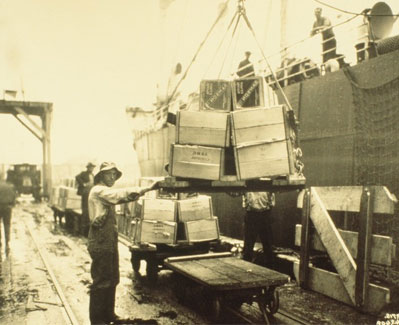


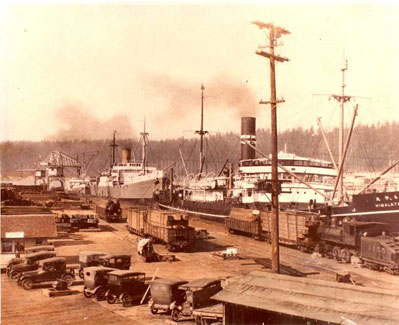






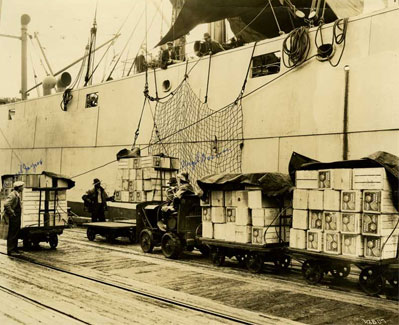


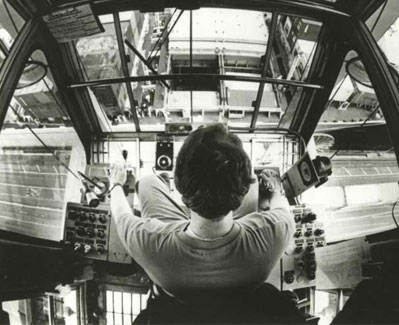

Longshore Photo History Links below lead to photo collections, videos, primary source documents, digitized newspaper articles, links to related materials, and more.
In the era before containerized shipping, longshore work was labor intensive, requiring complex teams of workers to clear and load cargo. These included longshoremen, gang bosses, hatchtenders, winch drivers, donkey drivers, boom men, burton men, sack-turners, side runners, front men, and jitney drivers. Long hours and irregular work was normal. Employers were able to leverage entry level jobs and throngs of workers seeking employment to reduce pay rates and lower standards and working conditions. In the “shape-up” system, workers had to ask for employment each morning, and jockey against each other for a job for the day. Additionally, employers could speed-up the work site by employing fewer workers, making the remaining employees work harder. They were also able to retaliate against non-compliant workers through a company union that kept track of workers with an employee “blue-book.”
Section Highlights
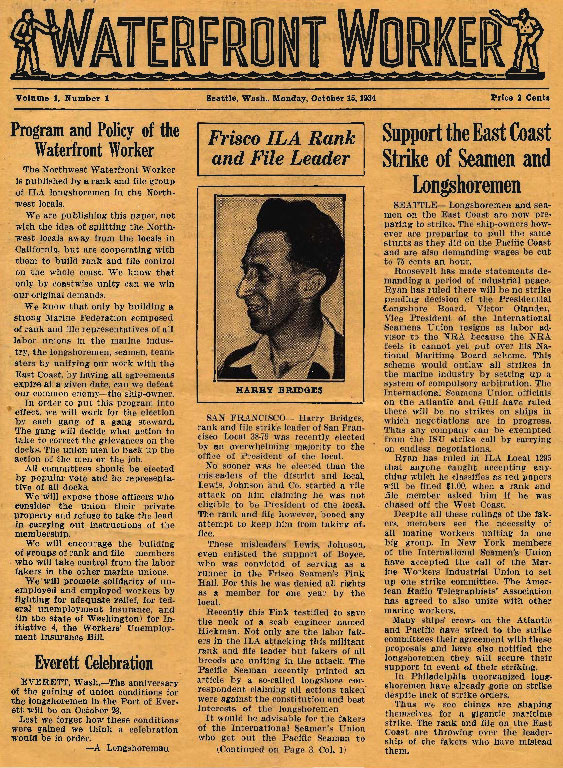
View documents and photographs of longshore history, including digitized copies of the Waterfront Worker (1932-1936) and photos from the Ron Madgen, Ross Rieder, Jerry Tyler collections and more.
Strikes
 Tour our special section on the 1934 West Coast longshore strike. In it you will find introductory essays on the strike, links to photographs and primary source documents, slideshows, videos, original newspaper articles and much more.
Tour our special section on the 1934 West Coast longshore strike. In it you will find introductory essays on the strike, links to photographs and primary source documents, slideshows, videos, original newspaper articles and much more.
The 1936 maritime strike secured the future of seven maritime unions and launched the ILWU. Here is a detailed report
The 1948 longshore strike ensured the survival of the leftwing ILWU in the midst of the Cold War. Here is a detailed report
The 1971 longshore strike was the third great victory for the ILWU. Here is a report and a database of contemporary newspaper coverage of the strike.
Videos and Oral Histories
Conditions like these led to many efforts to create authentic unions. Beginning in the late 19th century, longshore workers on the West Coast attempted to organize to better resist arbitrary employer control of the workplace. An early attempt, the Stevedores, Longshore and Riggers Union of the Puget Sound, lasted for a decade before foundering in the 1890s. The next significant attempt, the Longshore Union of the Pacific (whose founding charters are available here), quickly affiliated with the International Longshoremen's Association, the union of waterfront workers on the East Coast. In a dramatic strike in 1916 the ILA attempted to win union recognition in the West but were thwarted. In the face of fierce employer resistance and violence that took the lives of several union members, the strike was lost when San Francisco Bay Area locals decided to go back to work while Puget Sound area workers held out.
It wasn’t until the 1930’s and the great maritime strike of 1934 that workers were able to secure lasting union recognition. It was the 1934 strike that led to the establishment of the union that would become the International Longshore and Warehouse Union. This transition was important not just for the port workers who were transformed from “wharf rats” to the “lords of the dock,” but for the labor movement in general which built on the gains of dock workers in west coast cities.
Since that time West Coast ports have changed. The move to modern, containerized shipping in the 1960s meant enormous transformations for the industry. For one, fewer dock hands were needed, as towering cargo cranes now did most of the heavy lifting. Furthermore, waterfront warehouse locations have become less significant as containerized cargo is easily transported and unloaded far inland. Indeed, in southern California employers have attempted to circumvent union labor by trucking containers to interior valley warehouses for unloading. And in the early 21st century, employers have increased pressure on longshore workers in other ways as well. The 2002 ILWU contract negotiations saw employers locking-out workers, with the Bush administration threatening to use the National Guard if the union did not accede to employer demands.
Yet despite the ongoing conflict, longshore and port unions have survived, providing a standard of wage and working conditions that are emulated throughout the economy. On this page you will find additional material intended to share some of the history of Longshoring in the West.
A great place to start to further uncover the history of the longshore in the Pacific Northwest is with the records and publications of Ron Madgen. In our special section you will find photos and videos, and Magden's books on Seattle longshore history, A History of Seattle Waterfront Workers, 1884-1934, and Tacoma's waterfront workers, The Working Longshoremen.
The International Longshore and Warehouse Union webpage has a section on the history of the union with an excellent selection of oral histories compiled by historian Harvey Schwartz.
Local 19 of the ILWU has a very strong history section on their webpage, including dozens of short essays on the union, several pieces on Harry Bridges, and an amazing collection of historic photographs of the Seattle waterfront.
Our Harry Bridges page offers an array of materials for further exploration of the life and work of the forty year president of the ILWU. Included in this special section are historic photos, extensive video of Harry and the people that were close to him, and links to additional resources and institutions about Bridges.
Our special section on the 1934 Maritime Strike is an excellent introduction to the origins of West Coast longshore unionism and the industry in general. In it you will find a three part essay by Rod Palmquist on the strike, photos from scenes in the Northwest and elsewhere, video and slideshows explaining the basic narrative of the 83 day strike, newspaper articles, and more.
The timeline prepared by Blaine Holien provides a nearly comprehensive overview of significant events on the waterfront of the Pacific Northwest, and the compendium map displays geographically those events in Seattle.
Ashley Lindsey contributed two important reports about the rare but pivotal strikes conducted by the ILWU. 1948 West Coast Maritime Strike: Solidifying the ILWU and The 1971 ILWU Strike: 130 Days to Victory. See also her day-by-day record of the strike and database of 160 newspaper articles from that year.
Our Photos Collection provides unique and historically significant images of longshore workers and the industry in the Pacific Northwest. Of special note are Ron Magden, Local 23, and the Harry Bridges collections.
Finally, our site provides video and slideshow presentations about longshore workers and their unions. Especially interesting are a series of public addresses given in honor of longtime ILWU president Harry Bridges.